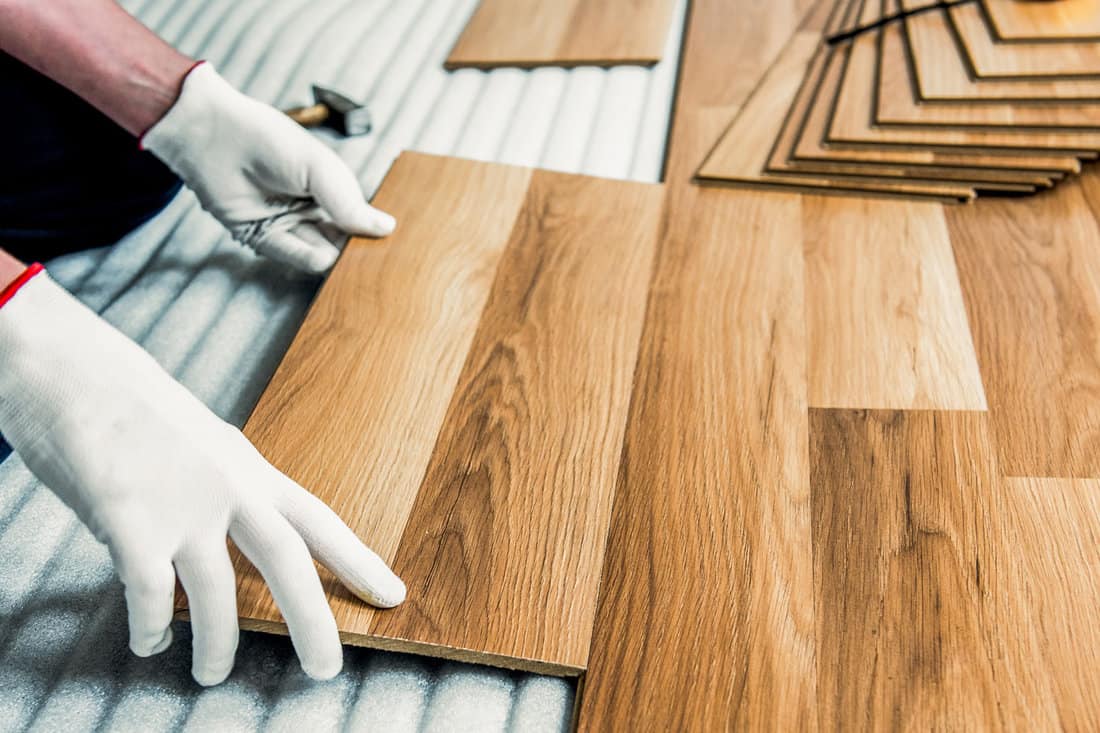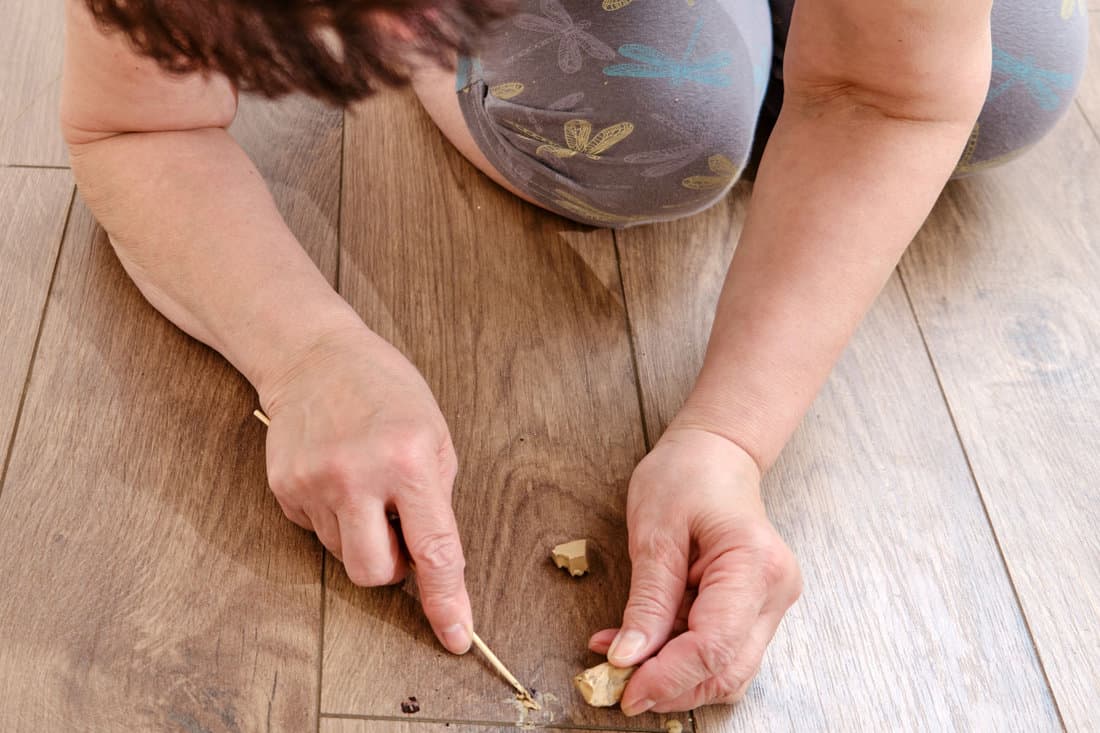If you're tired of feeling embarrassed every time someone steps into your home and sees your peeling laminate floor, you're not alone.
It's frustrating to see your once-beautiful floor in such a state.
To help you address the issue, we've outlined how to fix peeling laminate floors and make them look as good as new.
Let's begin!
Why is My Laminate Floor Peeling?

Many homeowners prefer laminate flooring due to its cost-effectiveness, durability, and low maintenance requirements.
However, one of the most common problems with laminate flooring is peeling.
If you have noticed that your laminate floor is peeling, there are several reasons why this may be happening.
Moisture
Moisture is the number one cause of peeling laminate floors.
When laminate flooring is exposed to moisture, it can cause the layers to separate, resulting in peeling.
The issue is usually attributed to leaking, spills, or the use of too much water when cleaning.
Subfloor Issues
Another reason why your laminate floor may be peeling is due to subfloor issues.
If the subfloor is uneven or damaged, it can affect the stability of the laminate floor, causing it to peel.
Improper Installation
Another reason is when your laminate floor has been installed properly.
This can happen if the flooring is not acclimated to the room's temperature or if the flooring was not installed with the correct adhesive.
Wear and Tear

Over time, your laminate floors may start to peel due to wear and tear. This is especially true in high-traffic areas of your home.
Also read: How To Make Laminate Floors Less Slippery
How to Fix Peeling Laminate Floor
Fixing a peeling laminate is a relatively straightforward process you can do yourself with the right tools and materials.
Here's how:
1. Prepare the Tools and Materials
Before you start, ensure you have all the necessary tools and materials.
You'll need the following:
- Fine-grit sandpaper
- Heat gun
- Putty knife
- Saw
- Adhesive
- Replacement laminate planks
- Rubber mallet
2. Get the Area Ready
Once you have everything you need, clear the area around the peeling laminate so you have plenty of space to work.
To begin, sand the area around the peeling laminate with a fine-grit sandpaper.
Doing so will help create a smooth surface and ensure the new laminate planks adhere correctly.
After sanding, wipe the area with a clean, damp cloth to remove dust or excess filler.
Another critical step is to use a heating gun from your floor repair kit to melt any remaining glue.
Simply direct the heating gun onto the glue until it is warm enough to melt.
3. Take Off the Peeling Laminate
We may include affiliate links and curated AI content to highlight top design styles.

Use a putty knife to pry up the peeling laminate gently. Be careful not to damage the surrounding laminate.
If the peeling is extensive, you may need to use a saw to cut it away.
Remember to wear protective glasses and gloves before you start cutting. This will keep you safe from any bits that might fly up.
Go slow and follow the shape of the boards as you cut.
Once the old laminate is off, you can throw it away or use it as a pattern to cut your new pieces.
4. Clean the Floorboards
Once you've removed the peeling laminate, use a vacuum or broom to clean the floorboards thoroughly.
Then, grab a damp cloth and wipe down the surface, especially the nooks and crannies.
5. Let the Floorboards Dry
Before you apply the adhesive, make sure the floorboards are completely dry.
If there's any moisture left on the floorboards, the adhesive may not stick properly.
6. Apply the Adhesive

Apply generous adhesive to the floorboards using a caulking gun or a trowel.
Make sure you spread the adhesive evenly over the entire area where the laminate will be attached.
After you've put glue on all the boards, give it some time to dry before you proceed to the next part.
7. Attach the New Laminate Planks
Begin by positioning the first plank at a corner of the space you're working on.
Carefully press each plank down, ensuring they snugly align with one another and the existing laminate.
You can gently tap them into place with a rubber mallet for a secure fit.
Make sure there are no gaps between the planks.
Continue reading: How To Cover An Expansion Gap In Laminate Floor?
8. Let the Laminate Planks Dry

Allow the adhesive to dry completely before walking on the new laminate.
The drying time can take several hours to days, so be patient and don't rush the process.
That's it! With these simple steps, you can fix peeling laminate floors and restore your flooring to its original condition.
How Do I Repair Scratched Laminate?

Repairing scratches on laminate flooring is a simple process and can be done with a floor repair kit.
To repair a scratched laminate, you must find a matching color repair kit.
Want your own? Try this one!
See the Katzco Total Furniture Repair Kit on Amazon.
Once you have the repair kit, follow these steps:
- Clean the scratched area thoroughly with a damp cloth and let it dry completely.
- Apply the repair compound to the scratch using the applicator in the kit. Make sure to fill the scratch completely.
- Use a plastic scraper to remove any excess repair compound from the surface of the laminate.
- Wait for the repair compound to dry completely, usually about 24 hours.
- Once the repair compound is dry, use fine-grit sandpaper to sand the surface of the laminate until it is smooth and level with the rest of the flooring.
- Finally, clean the area with a damp cloth and let it dry completely.
You might also like: How Long Does Laminate Flooring Last?
Tips on Taking Care of Laminate Flooring
Here are some tips to help you maintain your laminate flooring.
Avoid Dragging Furniture

Dragging furniture across your laminate flooring can cause scratches and scuffs, which can be unsightly and difficult to remove.
You can use furniture gliders or felt pads to reduce the risk of damage.
Promptly Clean Spills
Laminate flooring is resistant to water, but it is not waterproof.
Spills should be cleaned up promptly to prevent water from seeping into the floorboards and causing damage.
Use a damp cloth or mop to clean up spills, and avoid using excessive amounts of water.
Avoid Acidic Cleaners

Acidic cleaners, such as vinegar and lemon juice, can damage the protective layer on your laminate flooring and cause it to become dull and discolored.
Instead, use a mild, pH-neutral cleaner specifically designed for laminate flooring.
Always Have a Repair Kit Around
Even with the best care, laminate flooring can become damaged over time.
Always have a laminate flooring repair kit on hand to ensure that you can quickly and easily repair any damage.
These kits typically contain everything you need to fix minor scratches, chips, and other types of damage.
Professional vs. DIY Laminate Floor Repair
When it comes to fixing peeling laminate floors, you have two options: hire a professional or do it yourself (DIY).
Professional Laminate Floor Repair

Hiring a professional to fix your peeling laminate floors can be costly, but it comes with a guarantee that the job will be done right.
Professionals have the necessary tools, equipment, and expertise to repair your floors quickly and efficiently.
If you decide to go with a professional, make sure to do your research and choose a reputable company.
Look for reviews and ratings online, and ask for references from friends or family members who have had similar work done.
DIY Laminate Floor Repair

If you're on a budget or enjoy DIY projects, fixing your peeling laminate floors yourself can be a viable option.
Plenty of DIY laminate floor repair kits are available on the market to help you fix minor chips and scratches.
These kits typically come with filler products and instructions on how to use them.
However, if the damage is severe, you may need to replace the affected planks.
The process can be more involved and requires more time, tools, and expertise.
If you're not confident in your ability to do it yourself, hiring a professional is best.
Related article: How To Replace Laminate Plank In The Middle Of The Floor
Wrapping Up
Congratulations! You have successfully fixed your peeling laminate floor.
Remember that prevention is always better than cure, so maintain your laminate floor regularly to avoid any future issues.




